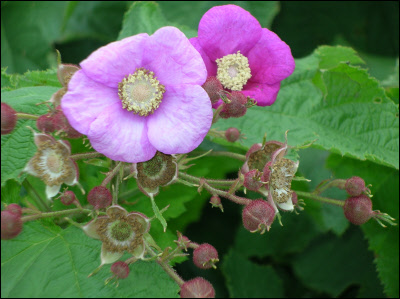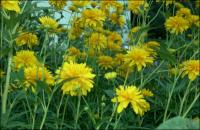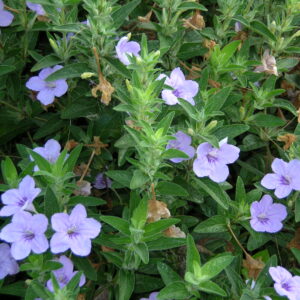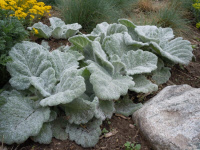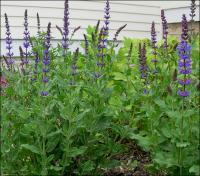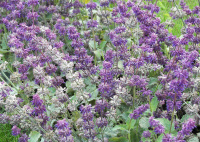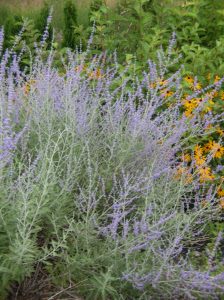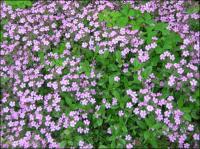Drought, Xeric & Dry Soil Plants
Showing 97–104 of 126 results
-
Rubus odoratus Flowering raspberry Z 2-8
Purple-pink saucer shaped flowers all summer
Purple-pink saucer shaped flowers from June to October. Rarely seen shrub.
Size: 7-8' x 8' spreading
Care: Sun to shade in moist well-drained soil. Slightly acidic.
Native: Maine to Michigan, south to Illinois, Tennessee, east to North Carolina and all places in between
Wildlife Value: Immune to walnut toxins.For sale in an English catalog in 1730. William Robinson, father of the mixed perennial garden, praised the flowering raspberry as bearing “large clusters of rich purple flowers. Bearing scented leaves, the leaves and not the flowers being fragrant.”
-
Rudbeckia laciniata var. hortensia Golden Glow Z 3-9
Imposing double daisies with multiple petals bloom atop a 6 or 7 foot erect stem as thick as a small tree trunk reign over neighboring flowers like a king. “Rich, yellow double flowers borne in autumn, excellent for cutting, “Sanders 1913. Blooms July-August.
Imposing double daisies with multiple petals bloom atop a 6 or 7 foot erect stem as thick as a small tree trunk reign over neighboring flowers like a king. “Rich, yellow double flowers borne in autumn, excellent for cutting, “Sanders 1913. Blooms July-August.
Size: 5-7' x 12" and spreading
Care: sun in moist well-drained to well drained soil, drought tolerant
Wildlife Value: Immune to Walnut toxinsSerendipitous discovery in a group of seedlings in 1894. Said to be “the most popular hardy perennial introduced during the last 25 years,” April, 1905, The Garden magazine. Recommended by Gertrude Jekyll in 1908. Beth in New Mexico advised that her alpaca named Ricardo finds them delicious.
-
Ruellia humilis Prairie petunia Z 3-9
Lilac open-face trumpets late June-October. Slow to emerge in spring so be patient. One of those non-flashy work-horses, a “MUST HAVE” plant of internationally known garden designer Piet Oudolf. Gardens Illustrated 94 (2013)
Lilac open-face trumpets late June-October. Slow to emerge in spring so be patient. One of those non-flashy work-horses, a “MUST HAVE” plant of internationally known garden designer Piet Oudolf. Gardens Illustrated 94 (2013)
Size: 10-12” x 10”
Care: sun in any soil
Native: Midwest south to Florida and Texas, Wisconsin native where it is endangered.
Wildlife Value: Pollinated primarily by long tongue bees who can reach far into the flower’s throat.Ruellia named for French royal herbalist Jean Ruell (1474-1537.) First collected by Thomas Nuttall (1786-1859) C.1810 English plant hunter who found more American plants than anyone else, early 1800’s.
-
Salvia argentea Silver sage Biennial or short lived perennial Z 5-7
Large rosettes of the woolliest silver leaves. So soft you want to pet them. Grow this for the leaves, not the flowers. It dies after flowering so cut back flower stems to prevent flowering, or, if you want to save seeds let it flower. It self-seeds sometimes.
Large rosettes of the woolliest silver leaves. So soft you want to pet them. Grow this for the leaves, not the flowers. It dies after flowering so cut back flower stems to prevent flowering, or, if you want to save seeds let it flower. It self-seeds sometimes.
LIMITED QUANTITIES AVAILABLE, LIMIT OF 1 PER CUSTOMER.
Size: 2-4’ x 12"
Care: Sun in well-drained soil.
Native: Europe & No. Africa around Mediterranean
Awards: Royal Horticultural Society Award of Garden Merit; Plant Select® Central Rocky Mountain regionSalvia is from the Latin “salveo” meaning “to heal” referring to the plant’s ancient medicinal uses. Collected before 1750. The Garden reported it was introduced in 1768. Liberty Hyde Bailey said its, “white woolly foliage makes it a very decorative plant.” (1933).
-
Salvia nemorosa Meadow sage, Balkan clary Z 5-7
Purple/lavender spire dense with flowers June to September
Dense purple spires flower June to September (if cutback after 1st flush of flowers).
Size: 36" x 24"
Care: full sun in moist well-drained to well-drained soil. Drought tolerant.
Native: Europe to Central Asia.
Wildlife Value: attracts butterflies & hummingbirdsSalvia is from the Latin word salveo meaning “to heal” referring to the plant’s ancient medicinal uses. Collected before 1753.
-
Salvia verticillata Lilac sage, whorley clary, Salbey Z 5-8
Muted lilac blue spikes June to October
Lillac flowers encircle erect stem spikes interspersed with bare, purple stems. June to October, deadhead for more blooms.
Size: 24” x 18-24”
Care: sun in moist well-drained to well-drained soil. Cut back after 1st bloom to repeat.
Native: Spain to Ukraine, Caucasus to Iran
Wildlife Value: Butterfly and bee magnet. Deer resistantSalvia is from the Latin “salveo” meaning “to heal” referring to the plant’s ancient medicinal uses. This species collected before 1753. Grown at America’s 1st botanic garden, Elgin Botanic Garden 1811.
-
Salvia yangii syn. Perovskia atriplicifolia Russian sage Z 5-9
Whorls of sky-blue flowers cover innumerable stems and their many branches creating a blue cloud from July through October
Whorls of sky-blue flowers cover innumerable stems and their many branches creating a blue cloud from July through October
Size: 4' x 4'
Care: full sun in moist well-drained to well-drained soil, Heat and drought tolerant. Cut back in spring.
Native: Afghanistan
Wildlife Value: deer & rabbit resistant, Feeds bees and honeybees
Awards: Great Plant Pick Award from Elizabeth Carey Miller Botanical Garden and Perennial Plant Association 1995 Perennial Plant of the Year.Perovskia was named for V.A. Perovski, governor of a Russian province in central Asia around 1890. Introduced to American gardens in 1904. Recommended by English garden maven Gertrude Jekyll in 1908.
-
Saponaria ocymoides Rock soapwort Z 4-9
Small bright pink flowers bloom along dense, creeping branches hugging the ground in late spring into summer.
OUT OF STOCK
Small bright pink flowers bloom along dense, creeping branches hugging the ground in late spring into summer.
Size: 3" x 18"
Care: Sun, well-drained soil
Native: Spain to Yugoslavia
Awards: Received England’s Royal Horticultural Society Award of Merit.Both the botanical and common names come from the plant’s use as soap, the leaves “yeelde out of themselves a certain iuice when they are bruised, which scoureth almost as well as sope.” Gerard (1633). Soapwort is still used today by antique and art restorers for its gentle cleaning: chop dried leaves and roots, boil in water for 5 minutes, and then agitate to make suds. William Robinson, father of today’s mixed perennial border gardens, praised this as bearing “masses of rosy blooms.”

